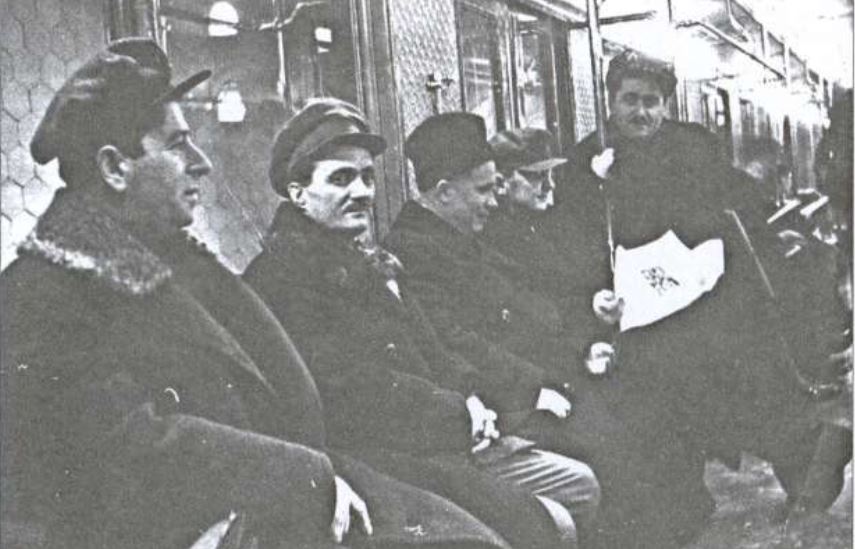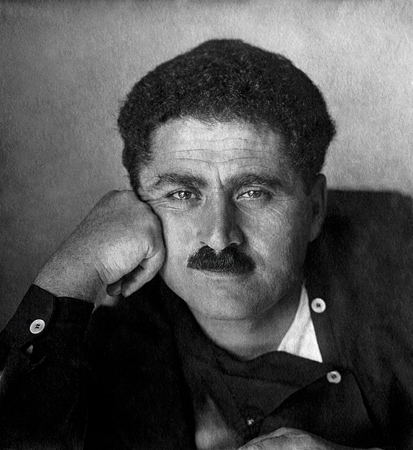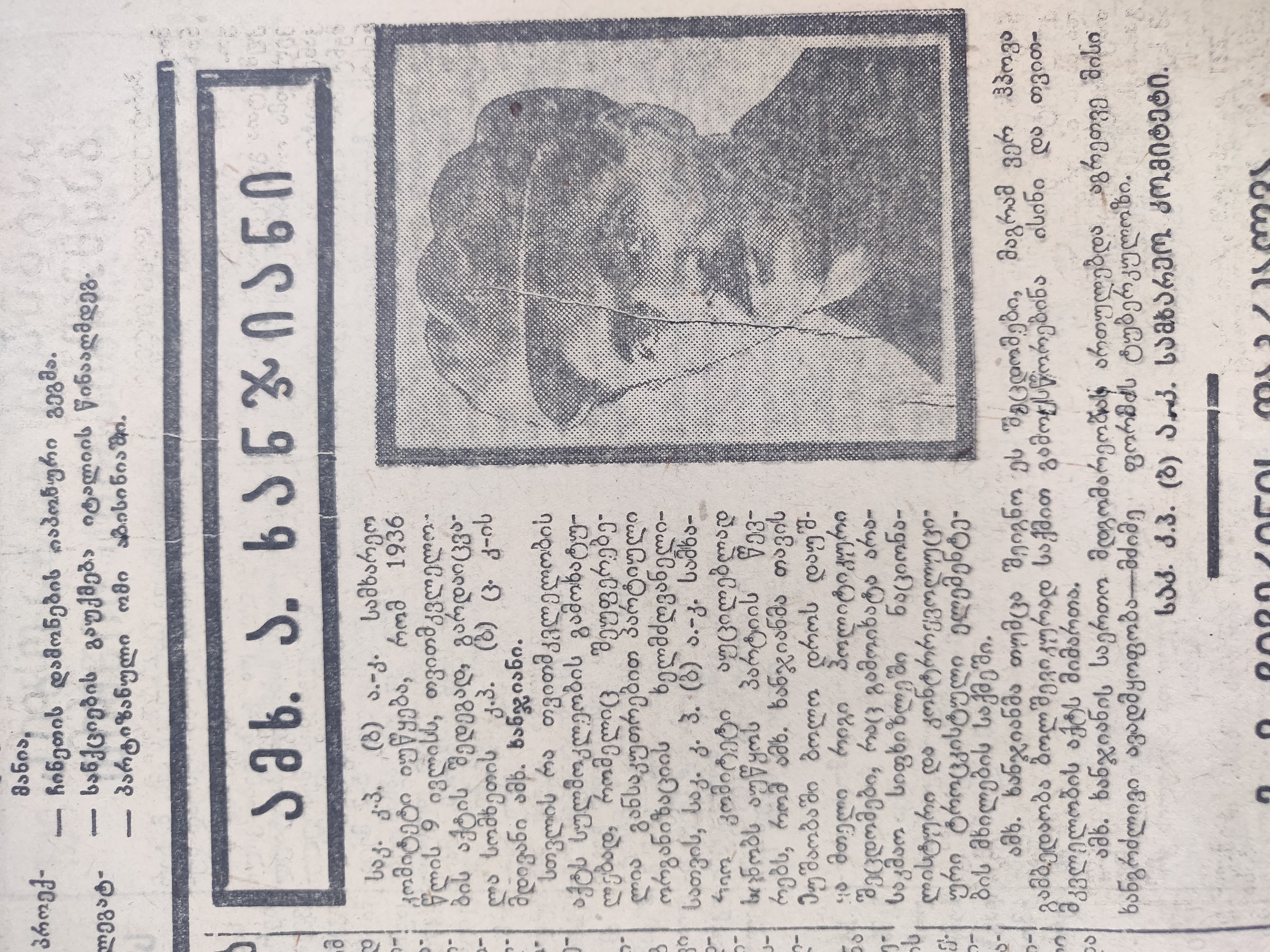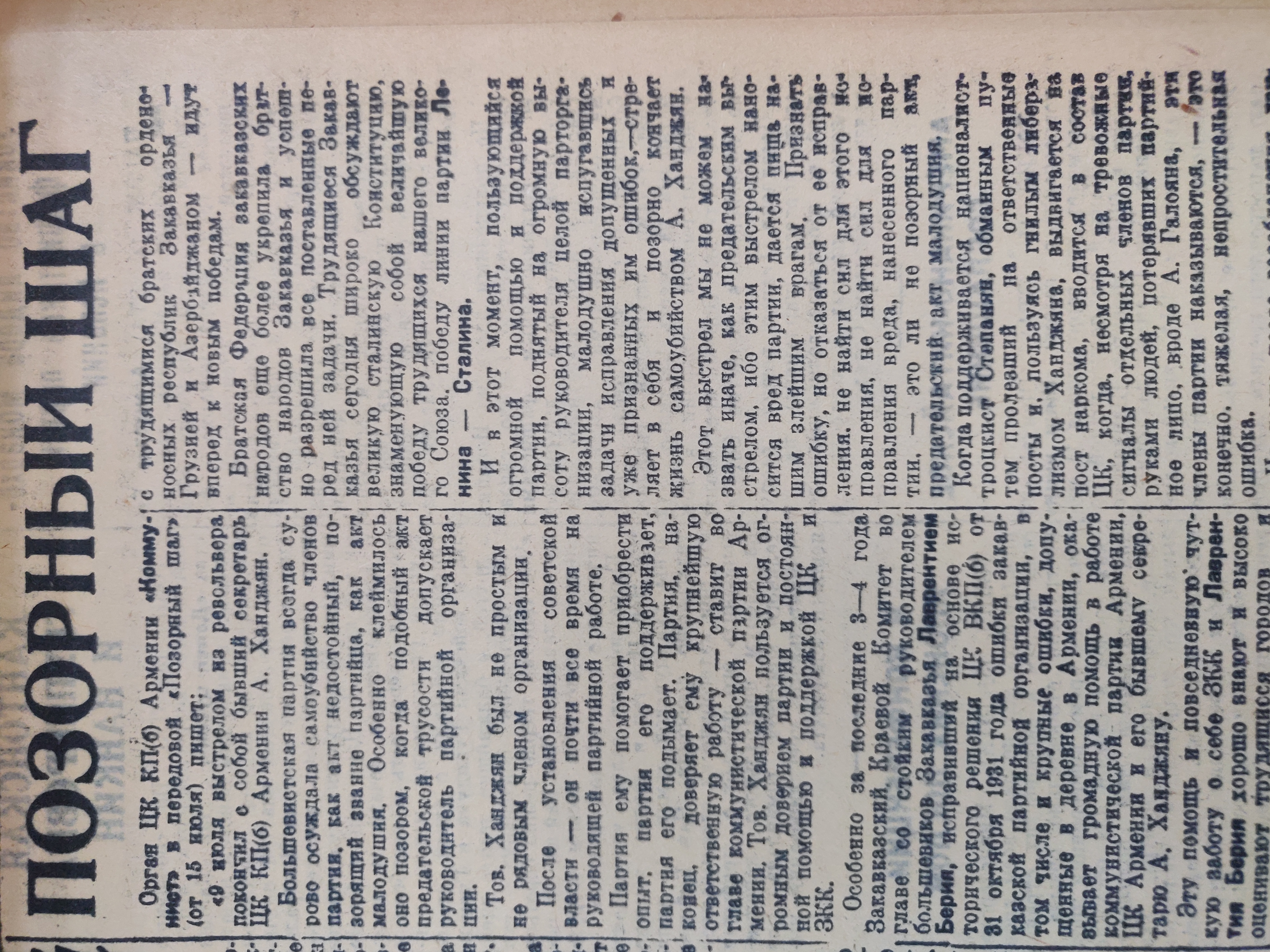


Author: Anton Vatcharadze
This article concerns the report and repressions against the Secretary of the Regional Committee of Bashkicheti (nowadays, Dmanisi), Otian, after the mystic case of the death of the First Secretary of the Central Committee of the Communist Party of the Armenian SSR, Aghasi Khanjian, because Otiani publicly expressed his opinion about Khanjian’s death, which was different from the official party version.
However, before discussing Otian’s story, it would be reasonable to briefly describe the circumstances, archival documents, testimonies, memoirs and historians’ opinions around Khanjian’s death.
Khanjian was a popular and young politician. He was born in 1901, in the city of the Ottoman Empire, Vani. At the age of 16, he became a member of the Communist Party. In Yerevan, he established the young communists’ organization “Spartak”. The government of the First Republic of Armenia (also known as "Dashnak Government" in the Soviet historiography) arrested him twice. After his party service in Leningrad in 1922-26, he returned to his homeland. In 1928, he became the Second Secretary and in 1930 – the First Secretary of the Armenian Central Committee. Meanwhile, he was a member of the Regional Committee of the Communist Party of Transcaucasia.

Mekhlis, Lakoba, Khrushchev, Beria, Khanjian – at the opening ceremony of the Metropolitan in Moscow, 1935
Soviet post envelope with Aghasi Khanjian’s portrait
On 9 July 1936, 35-year-old Aghasi Khanjian was found dead in the hotel room in Tbilisi. It is mentioned in several sources that Lavrentiy Beria killed Khanjian in his office and then ordered his body to be taken to the hotel room.

Aghasi Khanjian
In two days, on 11 July, on the first pages of the newspapers „Заря Востока“ and “Communist” the news about Khanjian’s death appeared. „Заря Востока“ called the suicide a shameful act:
“The Regional Committee of the Communist Party of Georgia announces that on 9 July 1936, the Secretary of the Armenian Communist Party, Comrade Khanjian committed suicide. While it observes a suicide to be a sign of cowardice and incompatible with the party leadership, the Regional Committee considers it necessary to inform the members of the Party that Comrade Khanjian had recently committed a number of political mistakes that were, mainly, revealed in the lack of attention toward the exposure of nationalist and counter-revolutionary, Trotskyist elements. Although Comrade Khanjian realized these mistakes, he did not find the courage to improve them through Bolshevik deeds and committed suicide. His prolonged illness – heavy tuberculosis - further complicated his condition.”

Communist, 11 July 1936

„Заря Востока“, 17 July 1936
Even Stalin voiced Khanjian’s surname in his speech at the Plenum of the Central Committee of the Communist Party of the Soviet Union held in Moscow on 4-7 December 1936. At the same plenum, an old Bolshevik revolutionary, Nikolai Bukharin’s fate was decided. He was arrested in January 1937, put on trial on the Second exemplary “Moscow process” and then executed. An excerpt from Stalin’s speech:
“Tomsky… I would advise you, Comrade Bukharin, to think why Tomsky committed suicide and left a letter – “I am clean”. You understand that he was far from clean, don’t you? If I am clean as a man, a human being and not a rag, not to say anything about me as a communist, then I will shout out loud that I am right. Suicide? Never! Nothing is clean here (exclamations from the audience: “That’s right!”). A person committed suicide because he was afraid that everything would become clear and did not want to be ashamed. Furer, Lominadze (Mikoyan’s exclamation from the audience: “Khanjian too”), Khanjian, Skripnik, Tomsky. [1] Here you have the easiest way to spit on the Party before death. Comrade Bukharin, here you have the background for the recent suicide cases” (source from the Internet №1)
After the Plenum, since December 1936, Khanjian’s suicide was evaluated as a provocative act against the Party and until Stalin’s death, any mentioning of his name or this case was practically banned. As a historian, Ronal Grigory Suny mentions, the new First Secretary of the Central Committee, Amatuni (Aik) Amatuni, appointed by Beria, first of all, started the exposure of the new heresy in the Party – Khanjianism and many of the old communists were executed during the 1937-1938 repressions for their links with Khanjian (Suny: 362). In his letter of 1937, Amatuni informed Beria: “10 months after the exposure of Khanjian, 1365 people were arrested in Armenia (including 900 Dashnak-Trotskyists) (Ноев Ковчег: № 19 (202) Октябрь (16–31) 2012). On 28 July 1938 Amatuni was also executed.
One of the most interesting sources about Aghasi Khanjian’s death are the memoirs of Suren Ghazaryan, who was a participant in the developments of that time: “This should not repeat”. Before his arrest in 1937, Suren Ghazaryan had served at the security services in Georgia, Armenia and Transcaucasia. He directly accuses Beria of killing Khanjian:
“Beria was calm in terms of Azerbaijan. Mir Jafar Baghirov is his old friend, he will not betray him. Armenia is different. Aghasi Khanjian does not show his will to be a subservient tool for Beria. They needed to get rid of him. Beria sends his people to Armenia with special instructions: collecting kompromat against Khanjian. It is impossible to read Beria’s subordinate, Zhora Tsaturov’s testimony without indignation who was in charge of fostering intrigues around Khanjian in Armenia. However, Khanjian was very authoritative and the intrigues did not affect him” (Газарян: 175).
“Khanjian was called from Yerevan to Tbilisi for the Regional Committee meeting. On the same evening, we learned that he committed suicide. It was told that he planned the suicide in Yerevan and two letters were found in his pocket: one – farewell to his wife and another one for Beria, in which he, allegedly, writes that he became very confused and could not see the other way. Everything was pre-planned for staging the suicide. After a quarter of a century, it was established that Beria killed Khanjian in his own office. Beria was crying very hard for his victim and his body was sent to Yerevan with great honor” (Газарян: 175).
In 1953, the witness of “Beria’s Case”, Giorgi (Zhora) Tsaturov, who was also mentioned in Ghazaryan’s memories, said during his testimony [2]:
“Beria invited me for dinner at his place and told me about my transfer to Armenia. Then he added: “We should get rid of Khanjian. Those who were sent for fulfilling this task, have failed”. When I suggested he dismiss Khanjian, Beria responded: “I need a basis for dismissing him. You cannot find it”. When I moved to Armenia together with Akofov, we made speeches against Khanjian at the Central Committee meetings, for which we used different reasons… Then I was in Tbilisi and I entered Beria’s office by chance when Khanjian was also there. Beria started cursing me for criticizing Khanjian. He said that Khanjian was a great man and we needed to take care of him” (Ноев Ковчег:№ 19 (202) Октябрь (16–31) 2012).
On 19 October 1953, former Minister of Security of USSR, Vsevolod Merkulov was put on trial for the case of “Beria’s group”. According to the minutes of Merkulov’s interrogation, he was read excerpts from Zhroa Tsaturov’s memoirs and he confirmed their authenticity.
We learn one more interesting fact from Evgenia Baghdasaryan’s report sent to the Ministry of Internal Affairs of Ukraine in 1953. As the case concerned Beria, this letter was redirected to the Minister of Internal Affairs of USSR, Kruglov who sent it to the Chairman of the Council of Ministers, Malenkov. Baghdasaryan’s sister, Asia was a Gumedyan’s [3] widow while Evgenya lived in Tbilisi with her sister and brother-in-law. Excerpt from her letter:
“Khanjian was among the attendants of the Tbilisi conference, who also visited Gumedin’s place. Suddenly we learned that Khanjian, who was healthy on the previous day, returned to the guest house of the Council of Ministers at midnight and in the morning, he was found dead in his bed. According to the official versions, as he had tuberculosis, Khanjian died from bleeding. Khanjian felt well before that. The results of the medical examination were not published. He was sent to Armenia with the closed coffin and his relatives were not allowed to open it. Once Gumedin told us that Beria killed Khanjian. According to him, Beria called Khanjian to his office and suggested he kill himself but Khanjian refused. He was seen (do not remember by whom) burning some papers”.
In 1937, Gumedin was arrested. His death sentence has three signatures: Stalin, Molotov, Zhdanov and the date - 12.09.1938. (Ноев Ковчег:№ 19 (202) Октябрь (16–31) 2012)
The majority of historian, studying this period, says that Khanjian committed suicide or was killed.
Simon Sebag Montefiore: “Before his revenge against Lakoba, Beria was in Yerevan. After this visit, Armenia lost its First Secretary. Aghasi Khanjian either killed himself or was killed” (Монтефиоре: 116).
Ronald Gregory Suny: “At the beginning of July, Khanjian was called in Tbilisi. Unexpectedly, it was announced that the Party Leader of Armenia killed himself. Although the consequences around his death remain vague, presumably, Beria ordered his murder because he perceived Khanjian as a threat to his monopolized power” (Suny: 62).
Robert Conquest directly accuses Beria of killing Khanjian without considering the suicide version (Conquest: 754). Conquest has also indicated a source for this information: newspaper “Communist” published in Armenia on 28 November 1963. It should also be noted that Conquest makes a mistake here ad Khanjian died in July, not August.
Aghasi Khanjian’s suicide/death was periodically discussed in the Georgian press and online publications. Almost all of the articles and blogs (that, presumably, are based on the same source) tell how Aghasi Khanjian paid a visit to Beria, presented him an expensive Persian carpet as a present and asked him to give Javakheti land to Armenia. Furious Beria took a gun and killed Khanjian at the place. It is also mentioned that Stalin was personally informed about Khanjian’s murder and did not express dissatisfaction regarding this case (See, for example, the source from the Internet №2). This information is followed by different interpretations. For instance, a journalist of the newspaper “Asaval-Dasavali”, Dimitri Chubinidze addressed Otar Ioseliani with an open letter because of Ioseliani’s remark regarding Armenians’ contribution to building Tbilisi:
“Mr Otar, you have said such thing for which, in 1936, Beria shot Aghasi Khanjian dead in his own office!... Stay calm, Mr Otar, today. Neither Beria nor Stalin are alive and also there is no such a Georgian nowadays who would have shot you in your head for Aerminzation of Tbilisi, beloved and admired by our hero David the Builder!” (source from the Internet №3).
Donald Rayfield has a similar opinion but, according to him, Khanjian fell victim not because of the Javakhaeti lands but because of an inappropriate joke, saying that Tbilisi was an Armenian city (Rayfield: 518).
Other sources provide different details and interpretations about Khanjian’s murder but these sources lack credibility. According to one version, when an employee at the Party Control Commission, Ivan Korotkov entered Beria’s office, Beria was standing near the corpse and shouting that Aghasi killed himself. Also, there is a version that Beria was carrying Khanjian covered in blood in his hands and running in the corridor (for the author, lifting heavyweight Khanjian and running is hard to imagine – A.V.).
It is difficult to believe the version that Beria killed Khanjian in his office based on just several memoirs and nonreliable sources. It is not scientific to develop some kind of argumentation on whether Beria could have done this or not as long as there are no documents that would prove the historical authenticity of this fact.
According to the author's opinion, it is unlikely that Khanjian brought a carpet to Beria’s offices and requested the transfer of lands to Armenia. Such issues were not settled in this way and Khanjian was an experienced party worker who well realized the situation. Also, it is hard to believe Donald Rayfield’s version that he was killed due to an inappropriate joke. Moreover, it is impossible for Beria to have killed a person in his office in front of many witnesses. There were much more refined and quiet means for getting rid of a person in the Soviet Union. Also, it has been proved that Ivan Korotkov truly worked in Tbilisi at that time and had an office and the Central Committee building. In 1949, he died from a natural death (source from the Internet №4). It is hard to imagine that, during the repressions, Beria would leave someone, who had witnessed a murder committed by him, alive.
The sources indicating that Beria killed Khanjian are mainly the memoirs and testimonies of the 1950s. Such materials cannot be historical evidence because the authors of such documents had animosity with Beria. However, through the analysis, we can imply that, whether Beria killed him or not, Khanjian’s death contributed to the elevation of Beria’s reputation as an authoritative ruler of the Caucasus. Aghasi Khanjian was a young, energetic and popular politician in Armenia and Caucasus and, as Ronal Suny has put it, Beria might have perceived him as a threat to his authority and getting rid of him was truly in his interest.
Sacrificing Khanjian in this way and his discreditation should have been a signal for everyone that the system would not have mercy on anyone. In 1936, before the Great Terror, the officials of the Soviet Union, as well as newspapers, used propaganda of unprecedented scale – they portrayed suicide as a provocative act. Gradually, it became clear that diversion from the Party course or the expression of different opinion would not be tolerated. People only had a right to labor and silent obedience.
Otian’s Case
After Aghasi Khanjian’s death, there were interesting developments in the Regional Committee of Bashkicheti about which the documents are preserved at the MIA Archives of Georgia. On the evening of 10 July, the Secretary of Party Committee on Meat Products, Potskhverashvili visited Bashkicheti. Before starting his work, he went to the Regional Committee and met the Secretary, Otian and mentioned Khanjian’s suicide during their conversation. As Potskhverashvili writes in his explanatory note:
“As soon as he heard it, Otian felt bad, started walking chaotically in the room and repeated – “How did this happen?””
Potskhverashvili responded that Comrade Ishkhanov informed them about this on 10 July, on which Otian still reacted fiercely:
“He (Ishkhanov) is the same bastard as others who spread such rumors!”. Then he said to himself: “A person was brought to suicide”.
Otiani did not become calm even laters. Potskhverashvili left the Regional Committee building but returned in an hour. He was met with three additional employees at the Regional Committee. During their conversation, Otiani also condemned Styopa Akopov [5], sat in the car and, although others tried to convince him that it was already too late and it would be better for him to calm down, he went to Tbilisi.
As soon as he was given a chance, on 13 July 1936, Potskhverashvili informed about this comrades Beria and V. Bakradze [6].
“After this conversation, I wanted to contact Tbilisi to take permission to follow Otian and inform him but did not manage to establish contact. In the morning, between 6-12 AM I checked the products, after which I went to the Regional Committee and nobody was there. The door was locked. I went to the Deputy Secretary and gave him the examination materials, after which I came back to Tbilisi”.
In a few days, on 16 and 18 July, the Regional Committee and Bureau prepared two identical resolutions. Based on the documents preserved at the MIA Archives, it is impossible to find out whether Otian had been warned by someone about Potskhverashvili’s report or he evaluated the situation himself and started looking for the way out. Interestingly, both of these resolutions are signed by Otian as a Secretary while both of these documents concern the mistakes committed by him and several other workers at the Party and their activities incompatible with the Party line. With one more document, Otian sent these resolutions to the Central Committee of Georgia for the Committee to consider them and strictly react to Otian’s (himself) misdeeds.
The resolution adopted by the Regional Party activists is more pathetic, including more evaluations:
“The betrayal and provocative act of suicide was directed again the Party. This was the last shameful step taken by a traitor involved in nationalist mistakes and connections”.
The resolution repeated a basic “message box” that the Transcaucasian Bolsheviks and their leader, Lavrentiy Beria (described as “the best Stalinist”, “beloved Stalinist”, “experienced leader” in the documents) had many accomplishments but the bourgeois-nationalist, counterrevolutionary and Trotskyist elements, including Khanjian, undermined them. Beria and the Party would have helped Khanjian if he had confessed his mistakes and aimed at improving them.
Moreover, we learn from the documents that at the meeting of Party activists of Bashkicheti Comrades Mamulov and Goriachev made speeches about Khanjian’s death and fully agreed with the assessment of the Party activists. Based on the documents, it is not clear whether Beria’s deputy in 1946-1953, Stephane Mamulov was in place for reacting to the incident related to Otian or just made a written statement. However, it is clear that Otian’s behavior and Potskhverashvili’s note attracted the interest of high officials at Mamulov’s level.
The resolution finishes with the following statement: “Glory to the Leader of our Party and the workers of the whole world, Great Stalin!”
-1.jpg)
From the left: Sergo Ishkhanov and Kandid Charkviani. 1938
The resolution of the Regional Committee of Bashkicheti of 18 July 1936 states:
“It should be noted that Otian made a serious political mistake, which was expressed in inappropriate explanation of Khanjian’s suicide to some of the member of the Regional Committee (Akhmadov, Velizade, Mkheidze). According to Comrade Otian, Khanjian was encircled by squabblers, intriguers and they brought him to suicide. The Regional Committee of Transcaucasia was mistaken and Otian travelled to Khanjian’s funeral in Yerevan without warning Central and Regional Committees. After his return on 12.VII.1936 he did not provide the Bureau with the information about the real reasons for Khanjian’s death. Also, about reporting about his own mistakes, he limited his report to several members… Some of the members of the Bureau (Akhmedov, Velizade, Mkheidze) did not counter his anti-Party explanations sufficiently”.
From these documents, we find out that Otiani affected the other members of the Regional Committee – Akhmadov and Velizade. Potskhverashvili did not report anything about them. He informed the Party about his travel to Yerevan and Khanjian’s funeral. According to the final point of the document, Otian, Akhmedov, Velizade, Mkheidze, Kobaladze, Siladze and Karsanidze shared the responsibility to explain Khanjian’s death to the party organizations of the Bashkicheti district villages. Most importantly, the document signed by Otian and sent to Tbilisi encouraged the Communist Party of Georgia to examine Otian’s case exceptionally strictly.
On 29 April 1937, at the beginning of Stalin’s repressions, Sedrak Otian was arrested. Soon, he was included in Stalin’s second list, received by the Georgian SSR for execution on 26 June 1937. On 13 July 1937, on the first anniversary of Potskhverashvili’s report, Otian was executed.
Today, it is difficult to discuss what was the reason for repressions against Otian and if he would survive if he had not expressed his emotions in front of Potskhverashvili. Other members of the Regional Committee were repressed for different reasons and Otian could have been among them. However, this story perfectly shows the repressive nature of the Stalinist system and the absurdity of repressions. Several examples can be provided additionally:
A. Portrayal of a former Party member and “beloved comrade” as “an enemy of the people";
B. Portrayal of suicide as a divertive act against the Party and homeland (In July 1937, Paolo Iashvili’s suicide was also portrayed as a diversion and the poet was buried as an enemy of the people);
C. Deciding a person’s fate on the basis of one word or “anti-Party” activity;
D. Self-preservation for which people used various means, including reports against themselves;
E. Everyone against everyone. If a person did not inform the Party of someone, he/she would be informed sooner or later. However, there was no guarantee for anyone.
The several pages preserved at the MIA Archives reveal how the brutal system worked, which was created, basically, by one person – Joseph Stalin.
______
[1] Veniamin Furer, Besarion Lomiadze, Nikolai Skripnik and Mikhain Tomsky – all of them committed suicide between 1933-1936.
[2] Giorgi (Zhora) Tsaturov (1900-1962) – People’s Commissar on Communications, Nutrition and Trade of Armenia.
[3] Gumedini (Gurgen Dadiani) (1902-1938) – Third Secretary of the Communist Party of Transcaucasia. Minister of Agriculture of Georgia and Armenia. On 12 September 1938 he was sentenced to death.
[4] Sergo Ishkhanov (1904-1954?) – Soviet Party worker, high official in 1929-1954: Second and then First Secretary of Tbilisi City Committee, Deputy Chief of the Council of Ministers of the Georgian SSR. Member of the Supreme Council for three terms.
[5] Stephane Akopov (1897-1938) – Party worker in Tbilisi and Yerevan, born in Georgia. Second Secretary of the Communist Party of Armenia before his execution.
[6] Valeriane Bakradze (1901-1971) – In 1931–1937, he was the head of the unit at the Central Committee, chairman of the Council of Worker Deputies, Second Secretary of the Central Committee of the Communist Party of Georgia. In 1927-1946 – Chair of the Council of People’s Commissars. In 1947-1952 – Minister of Food Industry of the Georgian SSR. In April-September 1953 – Chair of the Council of Ministers of the Georgian SSR.
[7] Stephane Mamulov (1902-1976) – worker at the security organs of the Soviet Union. General-lieutenant. In 1946-1953, he was the Minister of Internal Affairs, Lavrenti Beria’s deputy. In 1953, he was sentenced to 15 years in prison. He served the full sentence in the Vladimir prison.
Sources:
Archival Sources:
1. MIA archive of Georgia, Fond №1, Inventory №102, Item №45, pp. 1-6.
Publications:
1. Ronald Grigor Suny, "Soviet Armenia," The Armenian People From Ancient to Modern Times, Volume II: Foreign Dominion to Statehood: The Fifteenth Century to the Twentieth Century, ed. Richard G. Hovannisian. NewYork: StMartin'sPress, 1997.
2. Газарян С. О. Это не должно повториться : Док. повесть // Литературная Армения. - 1988. - № 6. - С. 2-53; № 7. - С. 2-50 ; № 8. - С. 2-49 ; № 9. - С. 2-41 : портр.
3. Монтефиоре, С. С., Двор Красного Царя, “Амфора”, Москва, 2015.
4. Robert Conquest, The Great Terror: Stalin’s Purge of the Thirties, Penguin Random House UK, 2018.
5. დონალდ რეიფილდი, საქართველო - იმპერიათა გზაჯვარედინი (სამიათასწლოვანი ისტორია), „პალიტრა L“ თბილისი, 2019.
6. „Заря Востока“, 11 ივლისი 1936.
7. „კომუნისტი“, 11 ივლისი 1936.
8. „Ноев Ковчег“ Статья – Армяне в „Деле Лаврентия Берия“,№ 19 (202) Октябрь (16–31) 2012 года.
From the Internet:
1. http://old.memo.ru/history/1937/dec_1936/index.htm
2. http://www.intermedia.ge/ - Article: "Why did Beria kill the Armenian leader in his own office?"
4. http://hrono.ru/biograf/bio_k/korotkov_ii.php
___

This material has been financed by the Swedish International Development Cooperation Agency, Sida. Responsibility for the content rests entirely with the creator. Sida does not necessarily share the expressed views and interpretations.